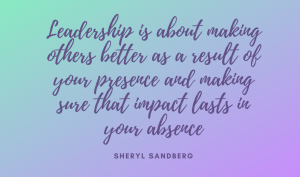 In the realm of business, politics, education, and beyond, leadership stands as the cornerstone of progress and success. Good leadership isn’t just about authority or power; it’s about inspiring and empowering others to reach their fullest potential. Let’s delve into the essence of leadership, exploring the qualities and actions that define exemplary leaders.
In the realm of business, politics, education, and beyond, leadership stands as the cornerstone of progress and success. Good leadership isn’t just about authority or power; it’s about inspiring and empowering others to reach their fullest potential. Let’s delve into the essence of leadership, exploring the qualities and actions that define exemplary leaders.
Leadership with Integrity:
Integrity forms the bedrock of good leadership. Leaders who uphold honesty, transparency, and ethical principles garner trust and respect from their teams. They lead by example, demonstrating integrity in their decisions and actions.
Empathy and Empowerment:
Empathetic leaders understand the perspectives and emotions of those they lead. By showing genuine care and compassion, they create a supportive environment where individuals feel valued and empowered. They recognise the strengths of their team members and provide opportunities for growth and development.
Adaptability and Agility:
In a constantly evolving world, good leaders embrace change and adapt swiftly to new challenges. They possess the flexibility and agility to navigate through uncertainty, guiding their teams with confidence and resilience. By fostering a culture of adaptability, they inspire innovation and creativity.
Decisiveness and Direction:
Effective leaders make timely and well-informed decisions. They provide clear direction and purpose, guiding their teams towards common goals. Through decisiveness, they instil confidence and certainty, driving progress even in the face of ambiguity.
Excellence through Collaboration:
Collaboration lies at the heart of good leadership. Leaders foster a culture of teamwork and collaboration, leveraging the diverse talents and perspectives within their organisation. By encouraging open communication and cooperation, they harness collective intelligence to achieve exceptional results.
Resilience and Responsibility:
Resilient leaders persevere in the face of adversity. They embrace challenges as opportunities for growth, inspiring their teams to overcome obstacles with courage and determination. Moreover, they take responsibility for their actions and decisions, accepting accountability for both successes and failures.
Servant Leadership and Strategic Direction:
At its core, good leadership is about serving others. Servant leaders prioritise the needs of their team members above their own, striving to support and uplift others to reach their full potential. They cultivate a culture of servant leadership, where empathy, humility, and selflessness reign supreme.
Strategic Direction in Leadership
A strategic direction serves as a roadmap to achieve organisational goals effectively. To craft a thoughtful plan, leaders must first define a clear vision and mission, providing a purpose-driven framework. Conducting a SWOT analysis helps identify internal strengths and weaknesses, as well as external opportunities and threats, informing strategic decisions. SMART goals should be set to ensure objectives are specific, measurable, achievable, relevant, and time-bound. From there, leaders can develop strategic initiatives aligned with these goals, allocating resources appropriately and creating detailed action plans with clear responsibilities and timelines. Regular monitoring of progress against key performance indicators enables adjustments to be made as necessary. Effective communication with stakeholders ensures alignment and support throughout the implementation process. By following this structured approach, organisations can navigate challenges and capitalise on opportunities to achieve their desired outcomes efficiently.
Humility and Humanity:
Humility is a hallmark of good leadership. Leaders who exhibit humility are approachable and open-minded, willing to listen and learn from others. They acknowledge their limitations and seek input from their team members, fostering a culture of inclusivity and collaboration. Furthermore, they treat others with kindness and respect, recognizing the inherent dignity and worth of every individual.
Inspirational Leadership:
Inspirational leadership goes beyond merely delegating tasks or issuing commands. It’s about igniting a flame within each team member—a flame fueled by passion and purpose. Inspirational leaders understand that when individuals are driven by a sense of meaning and fulfillment, they are more likely to excel in their roles and contribute wholeheartedly to the organization’s mission.
To ignite passion and purpose, inspirational leaders lead by example. They embody the values and vision of the organization, demonstrating unwavering dedication and enthusiasm in everything they do. By authentically showcasing their own passion for the work, they inspire others to find their own sense of purpose within the collective goals of the team.
Moreover, inspirational leaders take the time to connect with each team member on a personal level. They listen attentively to their aspirations, concerns, and ideas, fostering a sense of belonging and investment in the organization’s success. By understanding what drives and motivates each individual, they can tailor their approach to inspire and empower them to reach their full potential.
Inspirational leaders also communicate a compelling vision for the future—one that resonates with the values and aspirations of their team members. They paint a vivid picture of what success looks like, instilling confidence and excitement about the journey ahead. By articulating a clear and inspiring purpose, they rally the collective efforts of their team towards a common goal, fostering unity and camaraderie.
Ultimately, inspirational leadership is about creating an environment where passion thrives, and purpose is palpable. It’s about nurturing a culture where individuals are not just employees but active participants in a shared mission. By igniting the flames of passion and purpose, inspirational leaders unleash the full potential of their teams, driving innovation, creativity, and excellence.
 Perseverance: Be able to make it through challenging times
Perseverance: Be able to make it through challenging times
Perseverance is the unwavering determination to press on in the face of adversity. In the journey of leadership, challenges and setbacks are inevitable. However, what sets exemplary leaders apart is their ability to weather the storms with resilience.
Leaders who embody perseverance understand that setbacks are not roadblocks but opportunities for growth and learning. Instead of being discouraged by failure, they view it as a stepping stone towards eventual success. They maintain a positive outlook, focusing on solutions rather than dwelling on problems.
Moreover, leaders who persevere lead by example. They show their team members that setbacks are temporary and that with determination and perseverance, any obstacle can be overcome. Through their actions and words, they instill confidence and optimism, inspiring others to keep pushing forward even when the path ahead seems daunting.
Furthermore, leaders who persevere prioritize the well-being of their team members. They provide support and encouragement, recognizing that everyone faces struggles at one point or another. By fostering a culture of empathy and solidarity, they create a supportive environment where individuals feel empowered to persevere through tough times together.
Leadership excellence is a multifaceted journey characterised by all of the above elements and many more. By embodying these principles and practices, leaders can inspire positive change, drive innovation, and cultivate a thriving organisational culture. As we aspire to lead with excellence, let us remember that true leadership isn’t about titles or authority—it’s about making a meaningful difference in the lives of others.
To learn more about leadership, please check out my socials where I’m always posting useful videos surrounding the topic of being an effective leader, or have a look at my other blogs. https://real-resilience.co.uk/blog/
 Embracing 4 Values of Leadership
Embracing 4 Values of Leadership

 Holistic Leadership
Holistic Leadership
 In the realm of business, politics, education, and beyond, leadership stands as the cornerstone of progress and success. Good leadership isn’t just about authority or power; it’s about inspiring and empowering others to reach their fullest potential. Let’s delve into the essence of leadership, exploring the qualities and actions that define exemplary leaders.
In the realm of business, politics, education, and beyond, leadership stands as the cornerstone of progress and success. Good leadership isn’t just about authority or power; it’s about inspiring and empowering others to reach their fullest potential. Let’s delve into the essence of leadership, exploring the qualities and actions that define exemplary leaders.
 Perseverance: Be able to make it through challenging times
Perseverance: Be able to make it through challenging times Wellbeing: Whose responsibility is it?
Wellbeing: Whose responsibility is it?
 Mental Health at Work – Time for a Different Approach
Mental Health at Work – Time for a Different Approach an open and supportive environment where individuals feel comfortable discussing their mental health challenges without fear of judgment. Encouraging open communication, providing access to mental health resources, and offering flexible work arrangements are effective coping strategies that foster a mentally healthy workplace. this will only happen when mental health is spoken about openly from the top of the organisation down. If I am having a challenging time I share it with those working around me. How can I expect others to share unless I am prepared to go first!
an open and supportive environment where individuals feel comfortable discussing their mental health challenges without fear of judgment. Encouraging open communication, providing access to mental health resources, and offering flexible work arrangements are effective coping strategies that foster a mentally healthy workplace. this will only happen when mental health is spoken about openly from the top of the organisation down. If I am having a challenging time I share it with those working around me. How can I expect others to share unless I am prepared to go first! Employee Happiness:
Employee Happiness: Navigating the Challenges: A Coach’s Perspective
Navigating the Challenges: A Coach’s Perspective
 Metrics That Matter
Metrics That Matter How Coaching Can Unlock Your Team’s Potential
How Coaching Can Unlock Your Team’s Potential these challenges as opportunities for growth rather than roadblocks. They stay focused, maintain a positive mindset, and find creative solutions to overcome hurdles, fostering a culture of problem-solving within your team.
these challenges as opportunities for growth rather than roadblocks. They stay focused, maintain a positive mindset, and find creative solutions to overcome hurdles, fostering a culture of problem-solving within your team. Some employees are struggling with being back in the office. Quite a few companies require employees to return to the office full-time or increase the number of days. I have definitely noticed a trend so far in 2023. I know many people who are being urged to amp up their office presence. Typically, the request is for an increase of 3-4 days a week in the office.
Some employees are struggling with being back in the office. Quite a few companies require employees to return to the office full-time or increase the number of days. I have definitely noticed a trend so far in 2023. I know many people who are being urged to amp up their office presence. Typically, the request is for an increase of 3-4 days a week in the office.
 What about Gen Z?
What about Gen Z? Well-being is the feeling of being well and being able to take life in your stride. Gallup encapsulated the breakdown of wellbeing in their book “Wellbeing at Work”, breaking it down into 5 key aspects of wellbeing, that I believe, describe the different elements exceptionally well:
Well-being is the feeling of being well and being able to take life in your stride. Gallup encapsulated the breakdown of wellbeing in their book “Wellbeing at Work”, breaking it down into 5 key aspects of wellbeing, that I believe, describe the different elements exceptionally well: 10 Key tips to Incorporating Well-being into your organisation
10 Key tips to Incorporating Well-being into your organisation The Resilient Leader
The Resilient Leader